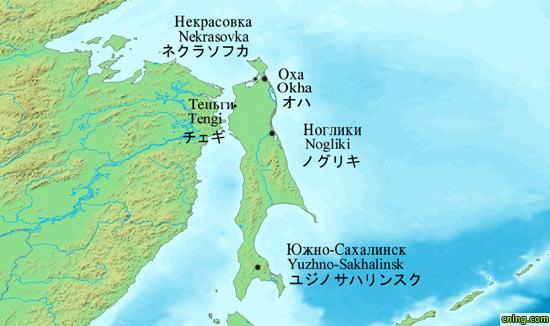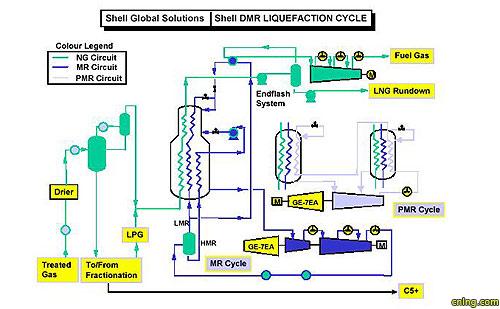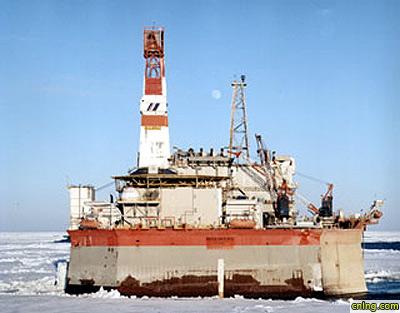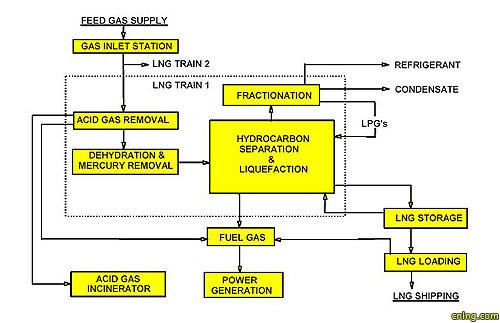Since 2001 the Sakhalin Island oil and gas project has been preparing to enter a new phase of production, with an extensive expansion project underway. The expansion involves an increase in crude oil production by way of new platforms and also the construction of a new liquefied natural gas (LNG) infrastructure for export of natural gas to international markets.
The project is led by the Sakhalin Energy Investment Company (SEIC) and will require a total investment of over $20bn (the original estimate of $10bn was revised in 2005 and some Russian agencies estimate the final investment at $28bn).

Map of Sakhalin Island showing major towns.
The Sakhalin Energy Investment Company is a joint venture between Gazprom (50% and one share) Royal Dutch / Shell Group (27.5%), Mitsui & Company (12.5%) and Diamond Gas-Mitsubishi Corporation (10%). Gazprom took a 50% stake in the project in 2006 (Russian Government exerted pressure through environmental concerns) for Ŭ50m.
Oleg Mitvol of the Russian Federal Service for the Oversight of Natural Resources threatened to revoke environmental authorisation for the Sakhalin II oil and gas production project in September 2006 (supported by Vladimir Putin).
By March 2007 the environmental dispute with the Russian Government had ended. Environmental controversy over the project however continues (salmon fishing, reindeer herding, Pacific grey whale and oil spillage risk).
PRODUCTION AND SUPPLY CONTRACTS
The sea around the Vityaz Production Complex is covered in ice for six months of the year and therefore production from Phase 1 is limited to the ice-free summer months.
Phase 1 of the Sakhalin Island project focused on oil development and went into seasonal production during mid-1999 at the Vityaz Production Complex. Phase 2 of the project is an integrated oil and gas development that will allow year-round oil and gas production. Of particular importance is the construction of new LNG infrastructure for the convenient export of gas.
SEIC has signed several deals with Japanese ndash; Tokyo Gas (1.1 million tons a year for 24 years from May 2003) Tokyo Electric Power Co (1.5 million tons a year for 22 years from May 20030 and Kyushu Electric Power Company (0.5 million tons a year for 21 years from 2003) – and Korean companies to supply LNG for the next 25 years. The Sakhalin II license area accounts for only 10% of the abundant hydrocarbon base of the Sakhalin shelf. Sakhalin II is creating infrastructure that can be used by other offshore Sakhalin oil and gas projects in the future. The Sakhalin II project phase 2 was 90% completed in 2008 (17,000 construction workers).

Schematic of the Shell DMR liquefaction cycle to be used in the LNG facility.
LNG AND OIL PROJECT
This involves the installation of an offshore platform (Piltun-Astokhskoye-B [PA-B]) on the Piltun feature of the Piltun Astoskhskoye field, and the installation of a single large platform (Lunskoye Platform [LUN-A]) at the Lunskoye gas field.
These platforms, as well as the Molikpaq platform (PA-A), will be linked to the shore by offshore pipelines. The oil and gas will then be transported via 800km onshore pipelines to Prigorodnoye, at the south of Sakhalin Island, the site of the new LNG plant and oil and LNG export terminals.
Yokogawa Electric Company was awarded the contract to supply and install the complete upstream measurement, control and safety systems for the whole of the project including onshore and offshore facilities. This will utilise state-of-the-art foundation field bus technology.
PILTUN-ASTOKHSKOYE-B (PA-B) PLATFORM
The Piltun-Astokhskoye-B (PA-B) is a drilling, processing and production platform that will extract oil and associated gas from the Piltun reservoir. Construction was started in the fourth quarter of 2003 and production began in the first quarter of 2007.
The platform is a four-legged concrete gravity base substructure (GBS) with a fully integrated deck construction that was engineered and constructed by Aker Kvaerner Technology AS and Quattrogemini OY. The platform has facilities for 140 personnel.

Sakhalin Molikpaq platform.
Estimated production capacities are approx. 70,000bpd (11,130m³/d) oil and 100MMscf/d (2.8MMm³/d) gas.
MOLIKPAQ (PA-A) PLATFORM
The Molikpaq offshore platform is the centre of the Vityaz Production Complex. It is a converted drilling rig that was first used in Arctic waters offshore Canada. In 1998, the Molikpaq was towed to Korea where it was upgraded for the Sakhalin II Project. It was then towed from Korea to Russia where a steel 'spacer', manufactured by the Amur Shipyard was retro-fitted to the bottom of the Molikpaq so that it could be used in the deeper offshore waters at Sakhalin Island. The structure was specially constructed for use in severe ice conditions. The completed steel and concrete substructure was filled with sand permanently anchoring it to the seabed.
During Phase 2 of the Sakhalin II Project the Molikpaq platform will be connected to the new pipeline infrastructure allowing year-round production.
Molikpaq sits 16km offshore, north east of Sakhalin. The platform is 120m wide, weighs 37,523t, and is home to over 150 people. Molikpaq is ballasted down with 278,000m³ of sand. In the winter, offshore temperatures, with the wind chill, drop to -70°C.

Schematic of the processes involved in the LNG facility.
LUNSKOYE (LUN-A) PLATFORM
The LUN-A platform will be located 15km off the north eastern coast of Sakhalin Island, in 48m of water. This is a drilling and production platform with minimum processing facilities. Oil / condensate and gas separation, including gas treatment for transport to the LNG plant, will be carried out onshore at the Onshore Processing Facility (OPF). This platform will produce the majority of the gas for the LNG plant. Construction was started in July 2003 and production will begin in 2008.
The platform is a four-legged concrete gravity base substructure that will be engineered and constructed by Aker Kvaerner Technology AS and Quattrogemini OY. The platform will have facilities for 126 personnel. Production capacity is estimated at 52 million cubic metres a day (1,800MMscf/d) gas, 8,000m³day (34,000bpd) liquids and condensate and 2,500m³/d (16,000bpd) oil.
ONSHORE PROCESSING FACILITY
The OPF is located off the north-eastern shore of Sakhalin Island, 7km inland from the landfall of the gas pipelines from the Lunskoye Platform. The construction contract for this facility ($250m) was awarded to BETS (Technostroyexport of Russia, Enka of Turkey and Bechtel of the US) in June 2003.
The OPF will primarily process gas and condensate received from the Lunskoye field, prior to transportation by pipeline to the oil export terminal and LNG facilities at Prigorodnoye. It will also receive oil and gas streams from the Piltun Platforms for transportation by pipeline to Prigorodnoye.
The gas and oil produced at the Lunskoye and Piltun-Astokhskoye fields will come ashore in two pipelines, after which the oil and gas will be separated. The OPF adds ‘antifreeze’ to stop the products freezing. This antifreeze is then removed and recycled for use again in a closed loop system. The OPF then cleans up the oil and gas and relays it on its way to storage or the LNG processing train.
The OPF facilities will include a 100MW power plant to generate power for the OPF itself and also up to 19MW for the Lunskoye platform. At full capacity the OPF will be capable of processing 1,800 million scf/d (51 million cubic metres a day) and about 60,000 barrels of condensate / oil per day (9,500m³/d).
Construction was started in the second half of 2003 and production start-up occurred in phases from the final quarter of 2005 to the final quarter of 2006. The construction of the OPF will use 13,600t of steel, 350,000km of cables, 88,000km of piping and 17,000m³ of concrete. The facility will be staffed by 70 personnel who will operate and maintain the plant. The OPF has been designed to meet all the required safety and environmental standards and will include state-of-the-art fire safety equipment.
The OPF site is in the north east of Sakhalin Island, and 70km away from the nearest settlement it is a remote spot and it takes 17 hours to get to the site – it's quicker to get to London from Sakhalin than to get to the OPF from the south of Sakhalin.
ONSHORE PIPELINES
Onshore oil and gas pipelines will run from Piltun in the north of Sakhalin Island via the OPF, near Lunskoye, to Prigorodnoye, in the south. The two pipeline systems will each cover a distance of over 800km, including 126km of swamp crossings and 110km over mountainous routes.
The distance from the Piltun landfall to the OPF is 172km (pipeline diameter 20in for both the oil and gas lines). The distance from the OPF to the LNG / Oil Export Terminal (OET) is 637km (pipeline diameters 24in and 48in for the oil and gas lines respectively). Two short multiphase pipelines (30in diameter, onshore length 7km) and a 4in Mono-Ethylene Glycol (MEG) pipeline in the same run will connect the landfall at Lunskoye to the OPF.
ZAO United Metallurgical Company (OMK) will produce and coat over 45,000t of pipe at its Vyksa Steel Works mill in an order worth in the region of $36m as part of a joint venture with Mitsui & Co. Ltd of Japan.
The contract will also require steel plate supplied by Severstal of Russia. Additional coated pipe for the project ($35m) will be produced by OOO Transpromresurs in a joint venture with Mitsubishi Corporation of Japan at their new high-tech coating plant in Vostochy.
The outside of the pipelines will be coated with a three-layer polyethylene coating to protect them from external corrosion. Both pipelines will be monitored using a state-of-the-art leak-detection system. Where the pipelines have to cross active faults, specially developed installation methods have been used to protect the pipelines in the event of seismic activity (designed to withstand an earthquake of 9 on the Richter scale).
The contract ($1.2bn) for laying the pipelines was awarded to Starstroi of Russia in a joint venture with Saipem, LukoilNephtegazstroi and AMEC / Spie Capag.
These companies will prepare the right-of-way, weld, trench, install and test the 1,620km of pipeline required for the onshore section.
OFFSHORE PIPELINES
The overall length of the offshore pipelines is approximately 165km. They will include:
Two 42km x 356mm pipelines from Piltun-Astokhskoye B platform (PA-B) to land
Two 17.5km x 356mm pipelines from Piltun-Astokhskoye A platform (PA-A or Molikpaq) to land
Two 13.5km x 114mm pipelines from Lunskoye Platform (LUN-A) to land
One 13.5km x 762mm pipeline from shore to LUN-A to provide gas to the facility
One 5.5km x 752mm tanker loading line from the OET to the TLU (Tanker Loading Unit) in Aniva Bay
LNG PLANT
An LNG plant has been built on a 490-hectare site at Prigorodnoye, Aniva Bay, 13km east of Korsakov. Aniva Bay has the advantage of remaining mostly ice-free throughout the year making it an ideal export location. The contract to develop the OET and LNG plant was awarded to a consortium of Russian companies, OAO Nipigaspererabothka (Nipigas) and the KhimEnergo consortium together with Chiyoda Corporation and Toyo Engineering of Japan. The KhimEnergo consortium includes: ZAO 'Engineering Corporation Transstroy', OOO 'Company IKEM' and OAO Angarsk Construction Division.
The LNG plant will be Russia's first and will have an annual production capacity of 9.6 million tons. The plant will eventually have two trains with an annual capacity of 4.8 million tons each. These will be some of the largest single trains ever built. However, if required there will be sufficient room on the site to build more trains at a later date.
The processing trains will use a Shell GSI B.V. licensed Double Mixed Refrigerant process (DMR). The Shell GSI DMR liquefaction process uses coil-wound type cryogenic heat exchangers for both the pre-cooling and the main cooling cycle. The cold climate on Sakhalin Island will also assist in air-cooling for the process.
The LNG plant will have two LNG storage tanks of 100,000m³ capacity and the LNG will be exported from an 805m jetty in Aniva Bay. The jetty will have two loading arms and one boil-off gas return arm. The loading of the specially designed tankers is expected to take between six and 16 hours depending on the size of the cargo.
In May 2008 the LNG plant saw the completion of the first train (4.8 million tons capacity). LNG train 1 at Prigorodnoye achieved its 'ready for start up' status and was handed over to the Sakhalin II operators.
OIL EXPORT TERMINAL (OET)
The OET is to be located 500m east of the LNG plant on the same site. The facility will provide oil storage in two tanks with geodesic domes and internal floating roofs. The total storage capacity will be 1.2 million barrels (190,000m³). A leak detection system will be installed in each tank foundation to prevent land contamination.
Crude oil is exported via a subsea pipeline to a tanker loading unit (TLU), which is located offshore in Aniva Bay, about 5km into the bay. Up to 50,000 barrels of oil can be loaded an hour (8,000m³/hr). The TLU will have a surge relief system installed to protect the tanker loading unit from overpressure and leaks in the event of a sudden shutdown.
INFRASTRUCTURE UPGRADE PROJECT
Extensive upgrades to Sakhalin Island's infrastructure were completed in 2007, in time for the start of phase 2 construction activities.
These upgrades, collectively referred to as the Infrastructure Upgrade Project (IUP), involve approximately $300m worth of improvements to Sakhalin Island's roads, railways, bridges, ports, docks and airports. In total these contracts encompass more than 50 construction sites and employ more than 2,000 staff across the length and breadth of the island. Work on the infrastructure upgrades began in 2002. Projects include:
Sakhalin Western Marine Port
Federal roads and bridges
Onshore Processing Facility (OPF) site works
Onshore processing facility Southern Access Road (SAR)
Railways
Phase 2 project office
Phase 2 accommodation facility
LNG site works


